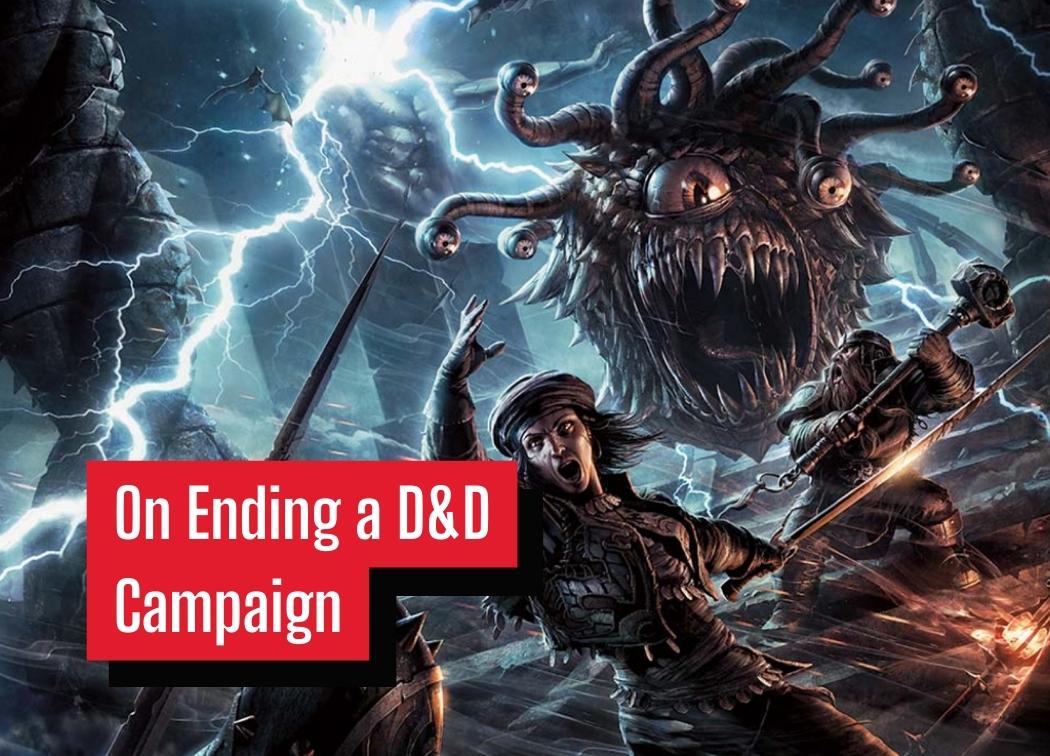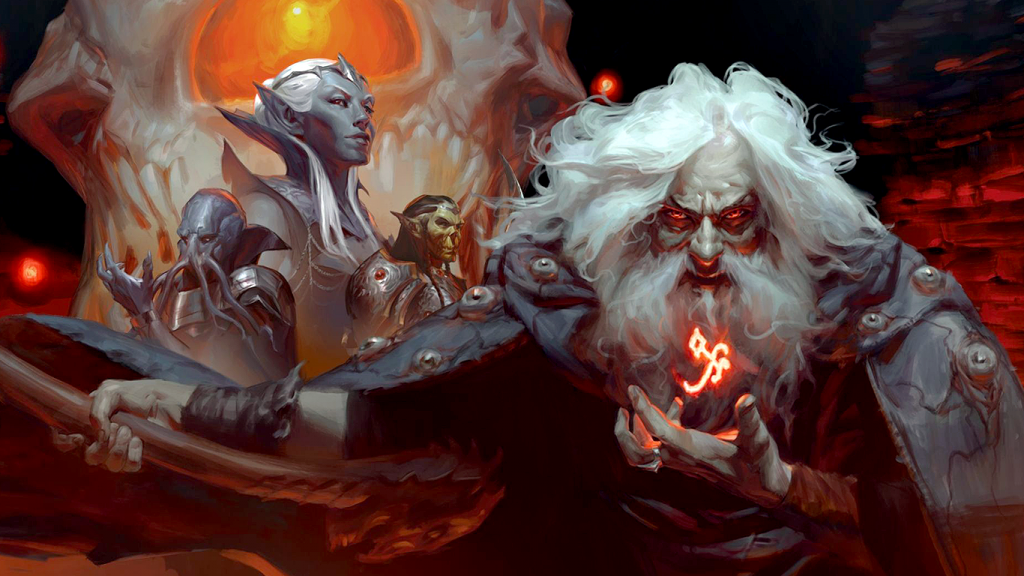On Ending a D&D Campaign

Today I want to talk about an issue I’ve been facing lately. This is a very opinionated topic so bear with me as I try and get back into the swing of things here on the site after the holidays. After all, the best way to break through writer’s block is to attack it head-on, right?
After college, I started up a new D&D 5e campaign with my old roommates. I made a whole new world and tried hard to focus on making more engaging encounters and dungeons. Most importantly, I kept it to six of us because I got super burnt out DMing for 9 people.
All in all, it’s been great. It’s easily the best campaign I’ve ever run, and I’ve gotten pretty damn good at making homebrew creatures and unique encounters.
However, it’s been uh… almost 4 years since college and we’ve been playing the same game for a little over 3 years. I’m itching for something new!
Thankfully, we’re at the point in the game where it’s making a logical conclusion. The hidden enemies that have been puppeteering wars and conflict for ages have revealed themselves, the party has the power to defeat them, and the party has built relationships with various NPCs to give them the tools to save the world.
I’m still figuring out how to wrap things up, but I also know that how I might wrap things up isn’t how the party will wrap things up. Let’s talk about ending a campaign, shall we?
Campaign Endings
Keep in mind that this is not a be-all-end-all list of how you can go about ending a campaign. Think of it more as a list of questions I asked myself as I have been thinking about certain outcomes and prepping for different possible situations.
For my prep, I’ve focused entirely on macro-level outcomes. For example, if they choose to fight X demon lord first, what would the opposing factions think/say/do? From there, I can see what their next steps could be.
After all, they could all choose to retire their characters and let the NPCs sort everything else out.
The point is, I don’t know what the true campaign ending will be, but I can facilitate situations and scenarios based upon the choices they’ve made throughout the campaign. That’s what you do when you wish to tie everything together and close the campaign. Show them the results of their choices.
What Were the Stakes
Every campaign is different.
While I will take a shot here and say that I believe most high-level campaigns result in some form of “save the world” scenario due to how 5e is structured, your campaign doesn’t have to reach that point. You could end a campaign early on in the character progression system or you could even have a relatively low-stakes campaign featuring high-level characters.
The build-up of the campaign has presented stakes to the characters. For the record, stakes are what are the consequences of X event happening. In the context of what we’re talking about it’s usually that an unfavorable outcome will happen unless you prevent X event.
I feel that it’s important at the end of a campaign to showcase (as best you can) what the outcomes were of all of the major stakes the campaign introduced. Tie up all of the loose ends and give the party the closure they deserve.
This should also include any situations or stakes that the party ignored, for better or for worse. Provided that the stakes are relevant to the ending of the campaign. Ignoring a scenario is still a choice, and perhaps one of the other deeds the party accomplished ended up solving this particular issue.
Or it could’ve made it worse. Who knows?
The Results
This is for sure the most obvious part about concluding the game. Show the party the results of their actions and decisions throughout the campaign, or at least the ones that had an impact on the ending.
The ending of the campaign should be the thrilling conclusion of the overarching plot that the campaign has focused on. This could be the storyline that you intended from the beginning, or the party may have chosen a different path down the line.
The end of the campaign should culminate in the party banding together and facing this evil creature or dangerous task head-on. Of course, the DM’s job is to play out the opposition of this scenario, but you should also reveal to them what happens after this threat has been vanquished.
Keep in mind too that you can still give them decisions to make to flesh out the epilogue/conclusion of the campaign.
Conversely, there’s also the chance that they fail in their endeavors. Don’t be afraid to give them an omniscient view of what happens to the world after they fail to stop this great evil.
The Sacrifices
Even if the party bests their foe handedly. Even if they hurdle over every obstacle. The party has still likely made sacrifices to get to the end of the campaign.
A sacrifice could be in the form of NPCs, the well-being of a city or town, resources, or even fellow party members. Success always has a cost. What did the party have to spend to succeed?
I think it’s important to show the party the impact of their choices. Even if the choices they made were difficult and had unfavorable outcomes.
What Happens to the Characters After?
Depending on the campaign you’re running and the group you’re playing with, you may wish to do some flavor of epilogue for the characters. This could be in the form of a cheesy 80’s movie with a blurb about each party member’s life, or it could be a whole session’s worth of content by itself.
Another suggestion for an epilogue is to give everyone the option of writing up their epilogue, or at least telling everyone else what their character does once everything is over. I think this is the best way to go about doing this.
I feel that having an epilogue or a “curtain-close” scene for the party is just as important to them as seeing how the whole campaign wraps up is to us. They’ve spent quite possibly, years playing the same character regularly, letting them all discover or determine how their characters live their lives after this brief period.

Future Appearances
I’ve had campaigns where I’ve utilized player characters as NPCs. I did a whole sequel campaign where the party interacted with their old characters.
I think, if done well, this can be a fun way for the players to see how the world changes and understand the differences between the two campaigns. Hell, there are even times where I’ll take a retired player character and use them in the same campaign to give the party guidance/aid when they need it.
Of course, I’ve made sure that this is a known possibility during session 0 or other conversations with the players. If your players aren’t cool with you reusing their characters then obviously don’t do that.
Besides, it’s easy enough to make your NPCs fill whatever position you’d have had for the throwback crew if your players aren’t comfortable with you using their old characters.
Conclusions
There we go, a nice stream-of-consciousness article to start the new year!
In all seriousness, this is the type of thought process that I go through when I’m trying to wrap up a campaign. Well, most of the time. Sometimes you just have to end a campaign a bit early, but I’ve been lucky enough to have the opportunity to have a fully fleshed-out ending for my longest-running D&D 5e game.
To wrap things up, I believe it’s important to showcase the party’s decisions, their successes, and their failures. Of course, these should be shown to the party through the lens of the campaign’s conclusion, as in what happens after they’ve thwarted whatever evil creature or event they had set out to thwart.
Giving the players an epilogue for their characters is also an important part of wrapping up a campaign. Give your players the option of deciding how their characters live out the rest of their lives after their big adventure. Of course, it’s a valid option for them to not bother with this, but I think most people would jump at the opportunity!

My primary D&D group is a work group where we meet during lunch once a week. Because of having less time to play, we play with milestone leveling once a month. When the party hit 10th level, I introduced a huge conflict in the story, because I think it’ll take them at least 6 months to get the items and information necessary to take on the end boss. If all goes well, there will be some kind of epic conflict once they reach 20th level, and then we can decide whether they want to retire and start anew, or maybe dabble in homebrew epic-level characters. I definitely agree that stakes and consequences are what makes the ending what it is!
I have a problem with my group. I haven’t gotten to play much in Adventurer’s League because of my schedule, but basically my entire group just goofs off and kills anything they encounter. I’m not sure how to solve it…
The two suggestions I have for this sort of issue is to either give the reasonable consequences for their actions or just simply talk to them.
As far as consequences are concerned, word travels quick. Who is going to work with these people if they go around killing anyone they meet? In fact, there are probably bounty hunters or law enforcement groups actively looking for the party if they’re truly this evil. On the flip side, you should also reward them when they don’t kill everything on site and use other methods to solve their problems.
Talking to them out of game is probably the most effective way to solve this proble though. I find that direct communication is the most effective way to solve thse types of problems. It could be that the group just isn’t a good fit!